Abstract
Mulberry (Morus alba L.) is the sole food source for the mulberry silkworm, Bombyx mori and therefore important for sericulture industry. Different abiotic stress conditions like drought, salt, heat and cold stress adversely affect the productivity and quality of mulberry leaves. Quantitative real time PCR (qPCR) is a reliable and widely used method to identify abiotic stress responsive genes and molecular mechanism in different plant species. Selection of suitable reference genes is important requirement for normalizing the expression of genes through qRT-PCR study. In the present study, we have selected eight candidate reference genes in mulberry for analyzing their expression stability in different abiotic stress treatments including drought, salt, heat and cold stresses. The expression stability of these reference genes was determined using geNorm, NormFinder and RefFinder statistical algorithms. The results showed that Ubiquitin and protein phosphatase 2A regulatory subunit A (PP2A) were the most stable genes across all the treatment samples. However, analysis of individual stresses revealed different expression profiles and stability of reference genes. Actin3 and PP2A were most stable in drought and salt conditions respectively. RPL3 most preferred in heat stress and Ubiquitin was most stable in cold stress. We propose the ubiquitin and PP2A are the preferred reference genes for normalization of gene expression data from abiotic stresses. In addition, Actin3 are preferred for drought stress, PP2A for salt stress, RPL3 for heat stress and Ubiquitin for cold stress studies.




Similar content being viewed by others
References
Zhu J-K (2016) Abiotic stress signaling and responses in plants. Cell 167(2):313–324
Gao JP, Chao DY, Lin HX (2007) Understanding abiotic stress tolerance mechanisms: recent studies on stress response in rice. J Integr Plant Biol 49(6):742–750
Osakabe Y, Kawaoka A, Nishikubo N, Osakabe K (2012) Responses to environmental stresses in woody plants: key to survive and longevity. J Plant Res 125(1):1–10. https://doi.org/10.1007/s10265-011-0446-6
Harfouche A, Meilan R, Altman A (2014) Molecular and physiological responses to abiotic stress in forest trees and their relevance to tree improvement. Tree Physiol 34(11):1181–1198. https://doi.org/10.1093/treephys/tpu012
Sarkar T, Mogili T, Sivaprasad V (2017) Improvement of abiotic stress adaptive traits in Mulberry (Morus spp.): an update on biotechnological interventions. 3 Biotech 7(3):214
Li T, Qi X, Zeng Q, Xiang Z, He N (2014) MorusDB: a resource for mulberry genomics and genome biology. Database. https://doi.org/10.1093/database/bau054
He N, Zhang C, Qi X, Zhao S, Tao Y, Yang G, Lee TH, Wang X, Cai Q, Li D, Lu M, Liao S, Luo G, He R, Tan X, Xu Y, Li T, Zhao A, Jia L, Fu Q, Zeng Q, Gao C, Ma B, Liang J, Shang J, Song P, Wu H, Fan L, Wang Q, Shuai Q, Zhu J, Wei C, Zhu-Salzman K, Jin D, Wang J, Liu T, Yu M, Tang C, Wang Z, Dai F, Chen J, Liu Y, Lin T, Zhang S, Yang H, Paterson AH, Xia Q, Ji D, Xiang Z (2013) Draft genome sequence of the Mulberry tree Morus notabilis. Nat Commun 4:2445. https://doi.org/10.1038/ncomms3445
Baranwal VK, Khurana P (2016) Genome-wide analysis, expression dynamics and varietal comparison of NAC gene family at various developmental stages in Morus notabilis. Mol Genet Genomics 291(3):1305–1317. https://doi.org/10.1007/s00438-016-1186-z
Baranwal VK, Negi N, Khurana P (2016) Genome-wide identification and structural, functional and evolutionary analysis of WRKY components of Mulberry. Sci Rep 6:30794. https://doi.org/10.1038/srep30794
Xiao Z, Sun X, Liu X, Li C, He L, Chen S, Su J (2016) Selection of reliable reference genes for gene expression studies on Rhododendron molle G. Don. Front Plant Sci 7:1547
Bustin SA, Benes V, Garson JA, Hellemans J, Huggett J, Kubista M, Mueller R, Nolan T, Pfaffl MW, Shipley GL (2009) The MIQE guidelines: minimum information for publication of quantitative real-time PCR experiments. Clin Chem 55(4):611–622
Czechowski T, Stitt M, Altmann T, Udvardi MK, Scheible W-R (2005) Genome-wide identification and testing of superior reference genes for transcript normalization in Arabidopsis. Plant Physiol 139(1):5–17
Pabuayon IM, Yamamoto N, Trinidad JL, Longkumer T, Raorane ML, Kohli A (2016) Reference genes for accurate gene expression analyses across different tissues, developmental stages and genotypes in rice for drought tolerance. Rice 9:32. https://doi.org/10.1186/s12284-016-0104-7
Wang C, Cui H-M, Huang T-H, Liu T-K, Hou X-L, Li Y (2016) Identification and validation of reference genes for RT-qPCR analysis in non-heading chinese cabbage flowers. Front Plant Sci 7:811. https://doi.org/10.3389/fpls.2016.00811
Machado RD, Christoff AP, Loss-Morais G, Margis-Pinheiro M, Margis R, Korbes AP (2015) Comprehensive selection of reference genes for quantitative gene expression analysis during seed development in Brassica napus. Plant cell Rep 34(7):1139–1149. https://doi.org/10.1007/s00299-015-1773-1
Tang X, Zhang N, Si H, Calderón-Urrea A (2017) Selection and validation of reference genes for RT-qPCR analysis in potato under abiotic stress. Plant Methods 13(1):85
Mascia T, Santovito E, Gallitelli D, Cillo F (2010) Evaluation of reference genes for quantitative reverse-transcription polymerase chain reaction normalization in infected tomato plants. Mol Plant Pathol 11(6):805–816
Tian C, Jiang Q, Wang F, Wang G-L, Xu Z-S, Xiong A-S (2015) Selection of suitable reference genes for qPCR normalization under abiotic stresses and hormone stimuli in carrot leaves. PLoS ONE 10(2):e0117569
Burgess DG, Ralston EJ, Hanson WG, Heckert M, Ho M, Jenq T, Palys JM, Tang K, Gutterson N (2002) A novel, two-component system for cell lethality and its use in engineering nuclear male-sterility in plants. Plant J 31(1):113–125
Wang M, Lu S (2016) Validation of suitable reference genes for quantitative gene expression analysis in Panax ginseng. Front Plant Sci 6:1259
Zhang Y, Han X, Chen S, Zheng L, He X, Liu M, Qiao G, Wang Y, Zhuo R (2017) Selection of suitable reference genes for quantitative real-time PCR gene expression analysis in Salix matsudana under different abiotic stresses. Sci Rep 7:40290
Dai F, Zhao X, Tang C, Wang Z, Kuang Z, Li Z, Huang J, Luo G (2018) Identification and validation of reference genes for qRT-PCR analysis in mulberry (Morus alba L.). PLoS ONE 13(3):e0194129
Chen X, Truksa M, Shah S, Weselake RJ (2010) A survey of quantitative real-time polymerase chain reaction internal reference genes for expression studies in Brassica napus. Anal Biochem 405(1):138–140
Wang Z, Chen Y, Fang H, Shi H, Chen K, Zhang Z, Tan X (2014) Selection of reference genes for quantitative reverse-transcription polymerase chain reaction normalization in Brassica napus under various stress conditions. Mol Genet Genomics 289(5):1023–1035
Liu D, Shi L, Han C, Yu J, Li D, Zhang Y (2012) Validation of reference genes for gene expression studies in virus-infected Nicotiana benthamiana using quantitative real-time PCR. PLoS ONE 7(9):e46451
Zhang K, Niu S, Di D, Shi L, Liu D, Cao X, Miao H, Wang X, Han C, Yu J (2013) Selection of reference genes for gene expression studies in virus-infected monocots using quantitative real-time PCR. J Biotechnol 168(1):7–14
Paolacci AR, Tanzarella OA, Porceddu E, Ciaffi M (2009) Identification and validation of reference genes for quantitative RT-PCR normalization in wheat. BMC Mol Biol 10(1):11
Jain M, Nijhawan A, Tyagi AK, Khurana JP (2006) Validation of housekeeping genes as internal control for studying gene expression in rice by quantitative real-time PCR. Biochem Biophys Res Commun 345(2):646–651
Andrade LM, Brito M, Junior RP, Marchiori PER, Nóbile PM, Martins APB, Ribeiro RV, Creste S (2017) Reference genes for normalization of qPCR assays in sugarcane plants under water deficit. Plant Methods 13(1):28
Zhu J, Zhang L, Li W, Han S, Yang W, Qi L (2013) Reference gene selection for quantitative real-time PCR normalization in Caragana intermedia under different abiotic stress conditions. PLoS ONE 8(1):e53196. https://doi.org/10.1371/journal.pone.0053196
Klie M, Debener T (2011) Identification of superior reference genes for data normalisation of expression studies via quantitative PCR in hybrid roses (Rosa hybrida). BMC Res Notes 4(1):518
Acknowledgements
The authors are thankful to Central Silk Board and CSR&TI, Pampore for providing financial assistant in the form of Project (Project code: PIB3579) and Seribiotech Research laboratory (SBRL), Kodathi, Bangalore for providing facilities to carry out the study.
Author information
Authors and Affiliations
Corresponding author
Ethics declarations
Conflict of interest
There is no conflict of Interest.
Additional information
Publisher’s Note
Springer Nature remains neutral with regard to jurisdictional claims in published maps and institutional affiliations.
Electronic supplementary material
Below is the link to the electronic supplementary material.
Rights and permissions
About this article
Cite this article
Shukla, P., Reddy, R.A., Ponnuvel, K.M. et al. Selection of suitable reference genes for quantitative real-time PCR gene expression analysis in Mulberry (Morus alba L.) under different abiotic stresses. Mol Biol Rep 46, 1809–1817 (2019). https://doi.org/10.1007/s11033-019-04631-y
Received:
Accepted:
Published:
Issue Date:
DOI: https://doi.org/10.1007/s11033-019-04631-y




